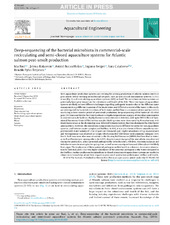| dc.contributor.author | Rud, Ida | |
| dc.contributor.author | Kolarevic, Jelena | |
| dc.contributor.author | Holan, Astrid Buran | |
| dc.contributor.author | Berget, Ingunn | |
| dc.contributor.author | Calabrese, Sara | |
| dc.contributor.author | Terjesen, Bendik Fyhn | |
| dc.date.accessioned | 2017-08-17T11:10:58Z | |
| dc.date.available | 2017-08-17T11:10:58Z | |
| dc.date.issued | 2016-10-20 | |
| dc.Published | Rud I, Kolarevic J, Holan A, Berget I, Calabrese S, Terjesen Bf. Deep-sequencing of the bacterial microbiota in commercial-scale recirculating and semi-closed aquaculture systems for Atlantic salmon post-smolt production. Aquacultural Engineering. 2016 | eng |
| dc.identifier.issn | 0144-8609 | en_US |
| dc.identifier.uri | https://hdl.handle.net/1956/16340 | |
| dc.description.abstract | New aquaculture production systems are evolving for prolong production of Atlantic salmon smolts or post-smolts before stocking in traditional net pens, such as semi-closed containment systems (S-CCS) in sea (Fig. 1) and recirculating aquaculture systems (RAS) on land. The microbiota in these systems can potentially have great impact on the robustness and health of the fish. These two types of aquaculture systems are likely to have different challenges regarding pathogenic invasion due to the different water management, e.g. different treatment of the intake water and different turnover of the water. In this study, we investigated the bacterial microbiota of both water and biofilms in a commercial RAS and in S-CCS in sea during a three months period of post-smolt production. Deep-sequencing of the bacterial 16S rRNA gene (V4) was used for the first time to obtain in depth compositional analysis of microbial communities in commercial scale facilities. Highly diverse communities were detected, with up to 2000 different Operational Taxonomic Units (OTUs) within samples. Both systems were dominated by Proteobacteria with Rhodobacteraceae as the dominating taxa, followed by Bacteroidetes that was dominated by Polaribacter among others. However, the microbiota composition was clearly different between the two aquaculture systems, and between water samples and biofilms. In RAS, it was also shown different microbiota composition with water salinity of 12 vs 22 parts per thousand (ppt). Higher abundance of e.g. Myxococcales and Nitrospiraceae was observed at 12 ppt, which coincided with lower total ammonia nitrogen (TAN) levels. Both taxa were also more abundant in the Moving Bed Bioreactor (MBBR)-biofilms than in water, as well as Planctomyces among others. In S-CCS, clear temporal changes of the microbiota was observed during the production, where potential pathogens like Tenacibaculum, Aliivibrio, Alteromonadaceae and Polaribacter were increasing in the spring time, as well as one unassigned taxa and chloroplast DNA likely from algae. The implication of these potential pathogens on fish health is unknown. A common observation for both RAS and S-CCS was higher abundance of the potential pathogens in the water compared to the biofilms. Further studies on the microbiota in closed-containment aquaculture systems are needed to obtain more knowledge about their impact on post-smolt production performance, welfare and health. | en_US |
| dc.language.iso | eng | eng |
| dc.publisher | Elsevier | en_US |
| dc.rights | Attribution-NonCommercial-NoDerivatives CC BY-NC-ND | eng |
| dc.rights.uri | http://creativecommons.org/licenses/by-nc-nd/4.0/ | eng |
| dc.subject | Microbiota | eng |
| dc.subject | Deep-sequencing | eng |
| dc.subject | Recirculating aquaculture system | eng |
| dc.subject | Semi-closed aquaculture system | eng |
| dc.subject | Biofilm | eng |
| dc.subject | Water | eng |
| dc.subject | Salinity | eng |
| dc.subject | Pathogens | eng |
| dc.title | Deep-sequencing of the bacterial microbiota in commercial-scale recirculating and semi-closed aquaculture systems for Atlantic salmon post-smolt production | en_US |
| dc.type | Peer reviewed | |
| dc.type | Journal article | |
| dc.date.updated | 2017-04-24T12:03:59Z | |
| dc.description.version | publishedVersion | en_US |
| dc.rights.holder | Copyright 2016 the authors | en_US |
| dc.identifier.doi | https://doi.org/10.1016/j.aquaeng.2016.10.003 | |
| dc.identifier.cristin | 1396667 | |
| dc.source.journal | Aquacultural Engineering | |
| dc.relation.project | Norges forskningsråd: 217502 | |
| dc.relation.project | Fiskeri- og havbruksnæringens forskningsfond: 900826 | |
| dc.relation.project | Norges forskningsråd: 237856 | |
| dc.subject.nsi | VDP::Matematikk og Naturvitenskap: 400::Zoologiske og botaniske fag: 480::Marinbiologi: 497 | en_US |

